Text
youtube
I really need to share this with everyone
#clodsire#pokemon#scientificpokedex#pokemon science#pokeearth#planet earth#david attenborough#Youtube
304 notes
·
View notes
Text
I haven’t updated this blog in a really long time, but I wanted to let you all know that ya girl just got her PhD! I’m a real life Pokémon professor now!

#not science#the PhD is in astrophysics if anyone is curious!#I’m kinda thinking of buying that graduation pikachu plushie for myself to celebrate#but all of the reviews are like ‘I bought this for my sons kindergarten graduation!’#and here I am almost 30 lol
376 notes
·
View notes
Text
I'm obsessed with pokemon doing just. weird animal things. A chatot trying to fight itself in the mirror. Flygon being a large weird lizard. Absol getting its scythe/horn stuck in things and needing to be rescued. Holding a torchic and moving it, seeing its head do the chicken thing. Furret being an absolute menace to society and stealing your socks to nest. Mr. Mime putting barriers around its food as a form of food guarding. Ninetales sleeping with its head tucked under its tails. Zigzagoon snuffling through the trash.
21K notes
·
View notes
Text

Still thinkin bout that little grass cat...Do people still do Pokemon variants?
2K notes
·
View notes
Photo

Requested by @bmmi20
According to the pokédex, Mightyena in the wild are often found in packs, traveling and hunting in groups around the Hoenn region. To learn more about this pokémon behavior, let’s turn to the analog in our world, a pack of wolves!
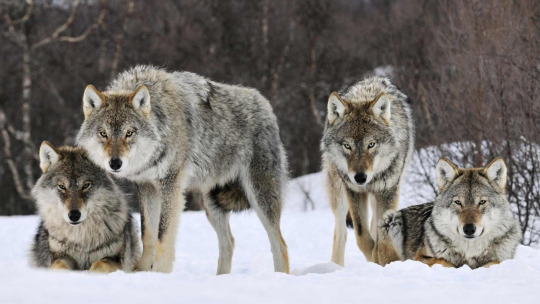
In the wild, wolf packs are almost always families, consisting of one pair of parents and their children. Wolves typically have 4-6 pups a year, and the children stay with the pack for up to 3 years until they leave to make packs of their own. Thus, the typical wolf pack has between 6 - 20 wolves at any given time.
The idea that wolf packs have a dominant “alpha male”, which all the other wolves fear and respect, is outdated and has been debunked. Historically, wolf behavior was studied using captive groups of wolves, like those found in zoos for example. These animals were not family groups like real packs, but rather unrelated rescues, or wild-caught creatures that are housed together. The fact that they are not related, and the fact that captive animals tend to be more aggressive in general (especially if they are not receiving adequate care), meant that the scientists studying the wolves observed a lot of hostile behavior, and the “alpha” hierarchy emerged where the strongest, most aggressive wolf was dominant.
In the wild, wolves simply don’t do that. Wolves within a pack rarely fight with each other at all. The point of a pack is to have safety and strength in numbers, and to care for and defend the younger, weaker pups as they grow up. If wolves were constantly fighting for dominance, that would defeat the entire purpose of a pack. As mentioned before, wolf packs in the wild are family groups. The closest thing to an “alpha male” is the parent wolves, who do lead the pack, care for their pups, decide when and where to hunt and eat, and occasionally discipline their pups. This picture of a strong family unit is far from the aggressive hierarchal structure people used to associate with wolves.
Mightyena live and travel in packs, usually made of two parents and up to 3 years of Poochyena pups. Mightyena do not respect and obey trainers that they perceive as stronger than them, but rather form the strongest bonds with trainers that care for and protect the Mightyena, like the parents in the pack do for their cubs.
#mightyena#pokemon#scientificpokedex#scientific pokedex#pokemon science#wolf#wolves#long post#Professor Julie
155 notes
·
View notes
Note
Hello there! I've just discovered this blog while researching for a Pokémon story about a Misdreavous being used as a treatment for clinical depression, and your entry on it was extremely insightful! I also loved your Litwick and Chandelure entries, since it's my favorite Pokémon line! I was wondering if it was possible to explore some of the ways Pokémon could be used in modern society, since I love when Pokémon appear outside of the context of battles. Keep up the great work, you're awesome!
Thank you! I also love to see when pokémon interact in more mundane environments. Here's a few random ideas, building off of yours:
Misdreavus in clinical scenarios, absorbing the stress and fear of patients
Chansey in a hospital to help cure the sick and injured
Stoutland used in Search & Rescue teams to help locate missing persons or save avalanche victims
Alakazam as a study buddy, helping their trainer prepare for an exam
A Klefki helping a forgetful trainer who always misplaces their keys
Garbodor cleaning up pollution and litter on beaches by eating it
Porygon or Rotom on an IT team in an office, entering into electronics to help fix technical problems
Appletun working in a bakery, keeping bug pokémon away from the treats on the shelves
Water or grass-type pokemon working on farms and gardens growing plants
What do you guys think? Reblog this adding your ideas on how your favorite pokémon would appear in modern society!
129 notes
·
View notes
Text










Everyday life of Pokemon
Animation by おしるこ | IG
82K notes
·
View notes
Photo

Requested Anonymously
Fennekin is one of those pokémon that has a near-perfect counterpart in our world. In this case, behold, the Fennec Fox:
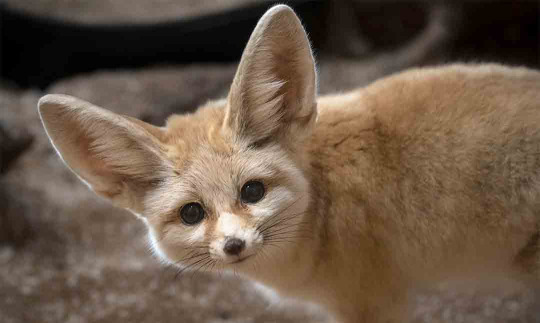
It shares Fennekin’s fox-like appearance, golden-colored fur, small stature, and of course, its very large and very adorable ears. Fennec foxes are native to the Sahara desert in North Africa. They are the smallest foxes on our planet, growing only to about 16 inches (0.4 m) long - exact same as Fennekin is listed in the pokédex!
Fennekin’s pokédex entry tells us that Fennekin commonly eats sticks. Fennec foxes primarily eat insects, but also eat plenty of roots and leaves in their diet like Fennekin as well! Scientists think that they eat these mostly for the plant’s water content - water is hard to come by in the deserts where they live, so eating plants is how these foxes stay hydrated.
But what about those huge ears?
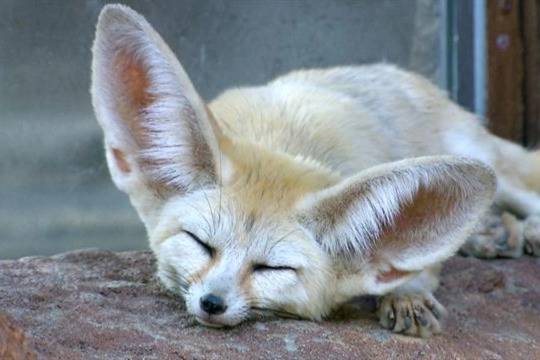
The first reason that these foxes have such large ears is because it helps them hunt their food. Since they eat bugs, they need to be able to hear faint sounds of bugs moving underground in order to hunt their prey. They are known to tilt their ears from side to side, listening for movement underground, before digging up their meal. Their large ears make it possible to hear such tiny sounds, making it easier for them to eat.
The other benefit to having such large ears is that their large surface area helps radiate away the fox’s body heat, keeping it cool in the hot desert environment. Human’s sweat to help regulate our temperature, but for a desert creature like the Fennec fox, water is precious, and you can’t waste any by sweating it away. So, it’s expansive ears, which are filled with blood vessels close to the surface of its skin, help dissipate off that excess heat and helps the fox stay cool. This is called thermoregulation, and the pokédex tells us that Fennekin does it too! As a fire type pokémon, Fennekin is probably very hot all the time - it’s large ears make it possible to regulate its body temperature efficiently.
Fennekin’s large ears help it hunt bug pokémon underground, and regulate its body temperature by expelling excess heat through the ear’s large surface area. It eats plant material to help stay hydrated.
#fennekin#pokemon#scientificpokedex#scientific pokedex#long dress#pokemon science#pokemon biology#fennec fox#Professor Julie
170 notes
·
View notes
Photo
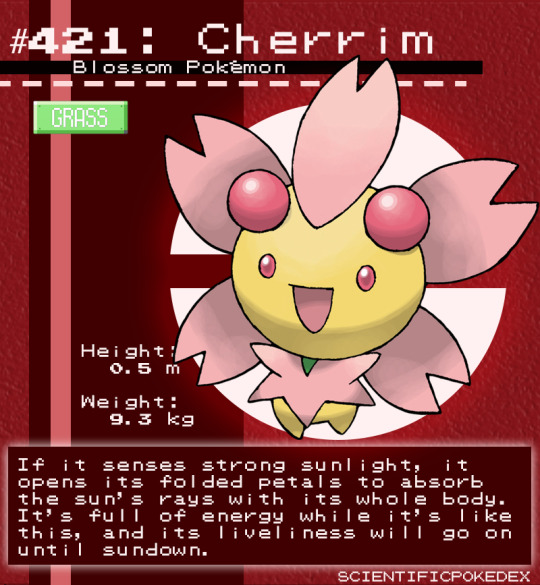
Requested Anonymously
Cherrim is a unique pokémon, who changes form depending on the weather. Most of the time, Cherrim keeps its flower closed, hiding beneath its tightly folded purple petals. In strong sunlight however, Cherrim blooms, opening up and becoming a beautiful pink flower.
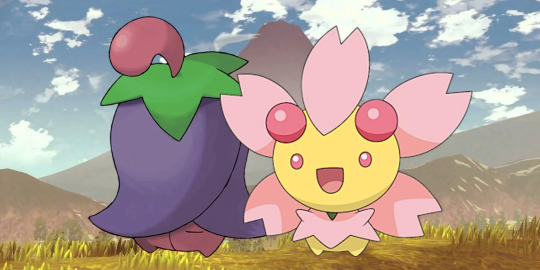
This type of behavior, a flower opening or closing its petals or leaves in response to sunlight, is called nyctinasty. There are plenty of nyctinastic flowers in our world, including tulips, the common daisy, magnolias, crocuses, and water lilies, which all share this common trait of folding up during the night, and blooming during the day.

Nyctinastic plants, like Cherrim, contain specialized pigments which sense and absorb light. You’ve probably heard of chlorophyll, a pigment that all plants have, that helps plants photosynthesize and absorb energy from sunlight. Nyctinastic plants additionally have a pigment called phytochromes, which detects red light specifically, allowing the plant to "see” when more red light is in the sky - typically near sunrise or sunset.
The interesting part is that many of these flowers will settle into a regular schedule, opening even on overcast days when the sun is out, or closing even when kept in a bright room at night. This leads scientists to believe that nyctinastic plants have a circadian rhythm, an internal clock, similar to the human’s sleep cycle. Just like when a human’s body tells them they need sleep every night, these plants can sense when it’s time to fold or open on schedule.
Scientists aren’t really sure why nyctinastic plants do their thing, but there are several strong theories. Pollen, the way that plants reproduce, loses its viability if it gets too wet, so it’s possible that these plants curl up to keep their pollen safe and dry, away from cold temperatures and morning dew. During the day, water evaporates easily in the sunlight, and bees are awake to spread the pollen around.
This doesn’t apply to every flower though. Moonflowers (pictured below) are an unusual type of nyctinastic flower which blooms during the night, and closes during the day. It likes the cooler temperatures, and scientists think that it does this to help gather water, instead of keep it away - the moonflower’s open petals collect dewdrops at night, and it curls up during the day to prevent the water from evaporating, so it can trickle down its stem and feed its roots.

Even though they why still may be a mystery, nyctinastic plants are very cool. Their ability to open and close their petals, and even sense the passing of time, reveals that plants are more complex than most people know.
Cherrim is a nyctinastic plant, who opens and closes its petals in response to sunlight. Its petals contain a special pigment called a phytochrome which senses sunlight, allowing it to know when to open or close.
#cherrim#pokemon#scientific pokedex#scientificpokedex#long post#pokemon science#pokemon biology#Professor Julie
180 notes
·
View notes
Text
Sometimes I like to think biology and taxonomy as a field is, if anything, even more complicated in the pokemon universe than it is in ours? Like it’d be really funny if the seemingly straightforward, reliable, and intuitive systems that are explained to us in the game is just the simple version given to young people who tend to be just starting out in their relationships with pokemon while across the country you have like. Professor Sycamore giving speeches about how much oversight was required to formally accept Fairy as a valid typing and getting derailed by a pundit talking about the Flying type and he’s like “Don’t talk to me about the flying type if you so much as look at the Flying type you’ll get into about eight taxonomical arguments that have been going on longer than you’ve been alive”
next door you have people arguing for the billionth time whether or not Cleffa should be recognized as a True pre-evolution of Clefairy or if the differences in its anatomy aren’t significant enough to classify and there’s at least one school of thought that Evolution doesn’t exist and the only real pokemon are final evolutions, so neither pikachu nor pichu are their own creatures they’re just immature and/or neotenous raichu.
Somewhere else in the world you have a paleontology conference discussing the latest fossils found of the ancient pokemon basculegion and reconstruction implications only for a time traveler to slam the rear doors open like “I SAW GOD, WAS THROWN BACK IN TIME, AND BASCULEGION DID NOT LOOK LIKE THAT,”
24K notes
·
View notes
Photo
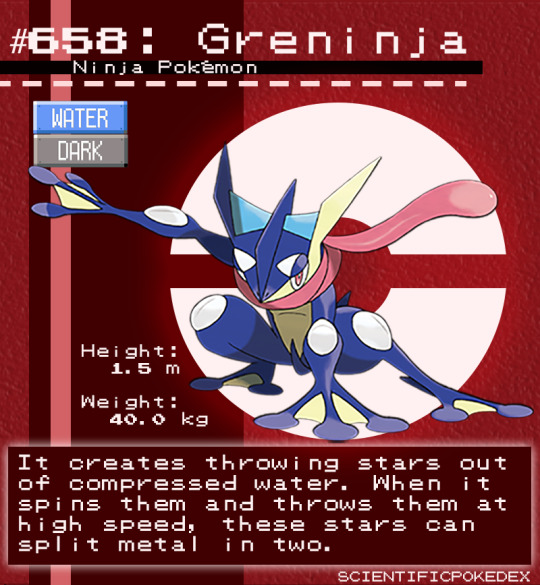
Requested by @caninotgetawhatnow and @chaosqueencierra
We’ve already talked a bit about Greninja’s tongue here. Greninja uses its tongue like a snake, to smell/taste the environment around it. The bigger the tongue is, the better Greninja could smell with it, so it evolved to be so huge that it no longer fit inside Greninnja’s mouth. But, since Greninja is a frog, its skin is covered in a layer of slimy mucus, which keeps Greninja’s tongue moist and clean despite being exposed to the air all the time.
Instead, I want to focus on Greninja’s ability to use water as a ninja star, a fast and sharp projectile weapon.

Water itself isn’t incredibly intimidating. The worst water guns do are get you wet, and even when dropped from thousands of feet in the sky as with rain, water simply won’t get fast enough to do any damage. Even if shot with high velocity, water quickly loses speed in air simply due to the nature of it. Water is a fluid, so under most circumstances it simply splashes off of something. And since water is not very dense compared to other materials, even if it does penetrate, Newton’s laws say it won’t go very deep. Still, like Greninja’s dex entry says, under the right conditions water can be used to even cut steel.

So how does Greninja do it? Water does have one thing going for it: water is incompressible, so its density and volume will not change. There are exceptions of course, but it’s generally a good assumption to make. Water will not squish or absorb impact like a marshmallow or a spring; it will act more like a bullet.
The issue becomes keeping water from separating and splashing into droplets. Especially since its spinning, one would expect the water to fly apart quickly in the air (think of a pizza dough being tossed, and flattening out). Greninja could actually use ice projectiles, that simply melt just before/on impact. But, if it’s shurkins are water, and not ice, high pressures and temperatures will do the trick. Water jet cutters, like the one pictured above, use high pressures and temperatures to shoot out streams of water. The high pressure enables the water to essentially pushes itself forward, which lets it cut the steel rather than splash off of it.
So for Greninja to weaponize water, it must shoot/spin the water so fast that the water is forced to continue its rotation before it gets a chance to fly off into droplets. This would require huge temperatures and pressures, certainly adequate to slice into the target on impact.
Greninja shoots water at high temperatures and pressures, which keeps the water from splashing apart before it impacts the target.
249 notes
·
View notes
Text
My take as a scientist who works with wild fish? Catching multiple Pokémon of the same species to complete the Pokédex is not only not problematic, it’s necessary. You don’t want a sample size that’s too small! That’s how you end up with misinformation. Imagine writing a whole-ass assessment of a species based on a single Alpha captured in the field… you’d get people INSISTING that Pikachu is six feet tall, and the smaller, more normal-sized ones are anomalies, haha.
This is just… how we do the research in my field; use the proper gear to capture a creature (a trawl net, seine net, or fish trap at my job, a Pokéball in the game,) take data, then release it… which the game encourages you to do by rewarding you with EV-boosting items when you return the Pokémon you don’t want to bond with to the wild!
And the fact that each Pokémon has a unique height and weight when you catch it, and that you’re encouraged to find out what foods it likes, what moves it likes to use, etc., feels a LOT more like science than the previous Pokédex-Completion aspects of the game had.
tl;dr, you don’t have to feel like an exploitative shitheel for capturing 25 Bidoof for the Pokédex and then releasing them… that’s just fieldwork, babey! You’re ensuring a proper sample size, which means good data, which increases understanding. You are a good scientist!
#pokemon legends arceus#pla#pokemon#pla spoilers#pokemon spoilers#not really spoiler but just in case#pokemon legends
19K notes
·
View notes
Photo

Requested by @tsukixnoxme
Alakazam, the classic first generation psychic pokémon, is known for being very, very smart. The pokédex entry in various games tell us that this is attributed to the large size of Alakam’s brain, which continuously grows larger over the course of its life.
Contrary to popular belief, there is little evidence that shows that having a larger brain makes an animal more intelligent. If that were true, whales would be the smartest animals on Earth, because they have the largest brains. Birds like ravens or crows have small brains, so they should be less intelligent by that logic, and yet, they are regarded as some of the more clever creatures on our planet. Here is a graph of brain size versus body size for several animals:

Unsurprisingly, larger animals have larger brains. Even corrected for body weight though, humans, which are typically regarded as the most intelligent creatures on Earth, do not have the largest brain size. If not brain size, then what about the brain determines an animal’s intelligence?
According to this study, it’s the type of brain cells that matters, not just the size. There are hundreds of different types of brain cells, called neurons, that have different roles in the brain. Cortical neurons, for example, are associated with memory, awareness, and consciousness. Sensory neurons translate information from your sensory organs, like your eyes and ears, to the brain. Motor neurons carry signals from your brain to your muscles, allowing you to move. Mirror neurons fire up when an animal observes a behavior in another creature, and then mimics it, and are linked with both empathy and language processing in humans.
Out of all of those, cortical neurons have the most correlation with intelligence in animals. Humans have a very high number of cortical neurons compared to other animals, which scientists think is responsible for our higher intelligence. On average, humans have abut 15 billion cortical neurons in their brain, compared to the 5.6 billion cortical cells in an elephants brain: which is impressive, because an elephant’s brain is much larger by mass. The brain of a cat (25 grams) is about 1/3 the size of the brain of a dog (74 grams), but cats have about twice the number of cortical cells in their brains!
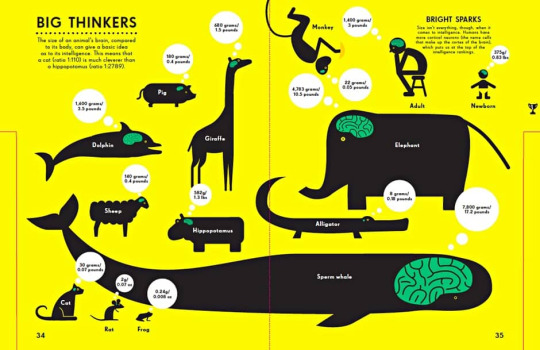
So with that, Alakazam not only has a large, ever-growing brain, but specifically produces more and more cortical neurons over the course of its life, resulting in more memory, higher perception, and, of course, presumably it’s psychic powers. That explains why it is more intelligent than a Wailord!
The process of growing new brain cells is called neurogenesis. Brain cells do not divide to reproduce through mitosis. Rather, they are created inside of stem cells, and live for as long as the body does. While most brain cells are created this way during developmental stages of an animal’s life - as an embryo, egg, or child - neurogenesis does continue through the adult stages of many species, humans included. Our brains, like Alakazam’s, are constantly growing bigger!
Alakazam’s brain contains a large number of cortical neurons, the type of brain cell associated with memory, awareness, and intelligence in animals. Although Alakazam’s brain is smaller in mass than a Wailord’s brain, it has more cortical neurons.
231 notes
·
View notes
Photo

Requested anonymously
During Cinderace’s signature move, Pyro Ball, this soccer-playing rabbit picks up a pebble and turns it into a ball of flame, kicking it into its rivals for devastating damage.

Rocks may not seem flammable intuitively, but in reality, some of the biggest naturally occurring fireballs in our world have the same humble origin, as a small rock being blasted through the atmosphere. I’m talking about meteors.
Meteors, also known as shooting stars, are rocks from space that burn up as they pass through the Earth’s atmosphere. The rocks themselves are usually fragments that broke off of a comet or asteroid, with sizes ranging from the size of a grain of sand up to the size of a boulder, several meters in diameter. Very bright meteors are called fireballs, for somewhat obvious reasons. Here’s what they look like:

The top two images there are real meteors observed on Earth (the bottom two are artists depictions), large space rocks that crashed through the atmosphere. The reason that meteors become fireballs and burn up in the atmosphere is because of ram pressure. The rock pushes on and compresses all of the air in front of it, building up high pressure and creating a shockwave. Meteors often reach temperatures of over 3000 degrees Fahrennheit this way, which makes the rock glow brightly and actually ignites the air it travels through, creating the signature long streaks of fire through the sky.
Fireball meteors usually don’t survive longer than a few seconds - the rock literally vaporizes, burning up and breaking apart miles before it hits the ground. These rocks are fast, clocking in around a speed of 20 kilometers per second (or 45,000 mph). So that should give you an idea on how hard Cinderace can kick.
Cinderace picks up a pebble and kicks it at speeds greater than 20 kilometers per second, igniting the pebble and turning it into a firey meteor.
#cinderace#pokemon#scientificpokedex#pokemon swsh#pokemon sword#pokemon shield#pokemon science#scientific pokedex#galar pokemon#long post#Professor Julie
312 notes
·
View notes
Note
I'm glad this blog is active again,it's one of the best things i've seen on tumblr :))
Thank you! It feels good to be back :)
32 notes
·
View notes
Photo
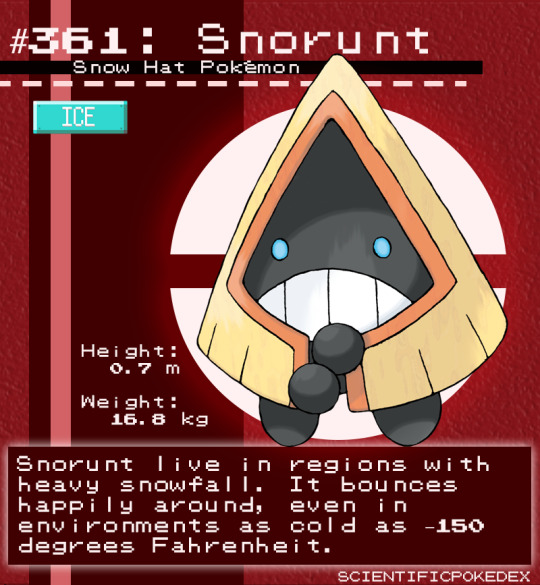
Requested anonymously
The adorable Snorunt thrives in cold temperatures, as low as -150 degrees Fahrenheit according to the pokédex! The lowest temperature ever recorded on our planet is -128.6°F (or -89.2°C), which was measured in Antarctica in 1982. To learn more about how Snorunt lives in similar environments, let’s take a look at one of Antarctica’s residents, the penguin!
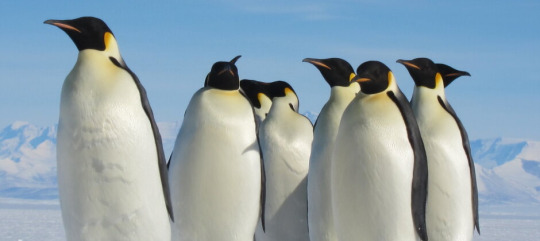
Penguins are able to stay warm due to their feathers - they have four layers of different feathers, which trap heat close to their bodies, like wearing four big blankets. They can puff out, or pull in, their feathers as needed to regulate their heat, and just about every part of their body is adapted to lose as little heat as possible as it functions. Penguins also famously huddle together to share warmth, which Snorunt does too! It’s pokédex entry from Black & White says “it is said that several Snorunt gather under giant leaves and live together in harmony.”
Of course, for any of this to apply to Snorunt, we’re making the underlying assumption that Snorunt needs to stay warm in order to survive. It’s possible that through *~*~pokemon magic~*~* Snorunt simply has a very low body temperature and is perfectly comfortable in cold weather. But for basically every animal in our world, including the penguins, the body needs to stay above a certain temperature in order to survive. The chemical reactions, blood circulation, and processes that we rely on to function are significantly slowed in cold temperatures. Besides, there is one piece of evidence that Snorunt needs to keep its body temperature above a certain level, even if it lives in extreme climates: it shivers!

Shivering is a way for muscles to generate heat, by contracting and expanding very quickly. This uses up energy, but ultimately produces heat to raise the body temperature back towards functional levels. If an animal’s body temperature is too cold, the heart has to work harder to pump blood, the cells in the body will shrink and dry out, brain activity slows down, muscles can stop working, and blood vessels can freeze - all of that happens during hypothermia.
There are some animals that can survive with surprisingly cold body temperatures, with clever mechanisms to get around this. There is an arctic squirrel, for example, who’s body temperature reaches a low 28 degrees Fahrenheit (-3 Celsisus) during its hibernation cycle. Similarly, there is a frog who completely freezes solid for months every winter (see our entry on Glaceon). In those examples, the animals’ bodies produce a natural anti-freeze substance that prevents their blood from freezing solid in the extreme cold. It’s likely that Snorunt has the same!
Snorunt’s coat contains different layers of fur to help regulate its body temperature, and it shivers to generate heat in its muscles. Snorunt likely also has a lower resting body temperature than most pokémon, producing cryoprotectants to prevent itself from freezing solid in extreme climates.
161 notes
·
View notes
Photo

Requested by @mindsnot
Appletun may look sweet, but according to it’s pokédex entry, it’s actually a ruthless predator. Appletun secretes a sweet-smelling nectar through its skin, attracting bug Pokémon for Appletun to then snack on. That’s a pretty brutal, yet effective, strategy for finding lunch. Just ask the pitcher plant:

Pitcher plants are a family of carnivorous plants - similar to the Venus Fly Trap - that get their nutrients from eating insects rather than absorbing them from the soil. They typically live in areas where the soil is thin or acidic, and due to the poor soil conditions they can’t get the nutrients they need from their roots like other plants. Instead, they adapted another method of getting what they need: consuming insects!
Pitcher plants in particular are characterized by their cup-shaped leaves, which are filled with a puddle of flower-scented nectar at the bottom. Unsuspecting bugs follow the sweet scent looking for a snack of their own, but end up becoming the snack. Once the insect falls into the cup, the waxy, smooth walls of the leaves make it so the bug can’t climb out again, and it ends up drowning in the pool of nectar. The nectar pool also contains digestive enzymes which helps break down the nutrients for the pitcher plant to absorb, kind of like the acid in your stomach. Appletun’s signature move, Apple Acid, makes a lot of sense in this context: its nectar attracts bug pokémon by the sweet scent, but the nectar is actually acidic, which helps it digest the bug pokémon to eat.
Appletun is part Grass-type, so the pitcher plant is a fair comparison, but it doesn’t explain the fact that Appletun looks more like a dragon than a plant, and the pokédex tells us that its nectar comes from everywhere on its skin, not only in its leaves.
To explain this we can look towards amphibians, like frogs and salamanders, who are known for having slimy skin!
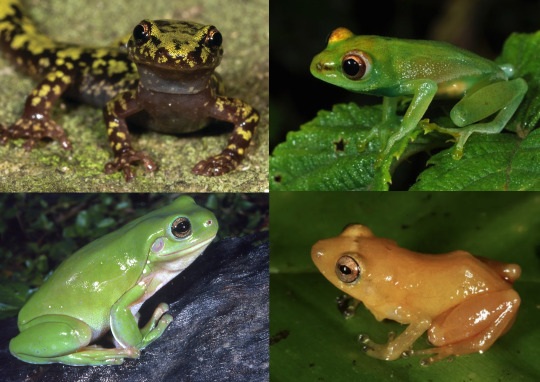
Amphibian skin needs to be wet to properly function: they “drink” through their skin to stay hydrated, and they absorb oxygen through their skin to breathe. It also helps them regulate their body temperature. The “slime” on an amphibians skin is actually a mucous, secreted by many glands throughout their skin, keeping them hydrated. Some salamanders also have beneficial microbes in their slimy coating to boost their immune system. Tree me frogs commonly use their mucous to help stick to leaves and rocks, enabling them to climb, and others have even adapted to secrete poison in it to deter predators.
Appletun’s skin must contain many mucous glands like an amphibian, which constantly secretes the sweet-smelling liquid all over its body. I like to think it has a similar texture, scent, and appearance to apple pie filling. The slime probably has multiple purposes, like a frogs, to help Appletun stay hydrated and regulate its body temperature. But most importantly, the sweet scent attracts bug pokémon, which Appletun can then turn into a tasty snack.
Appletun’s skin contains glands that secret a mucous that smells like sweet plant nectar. This slimy coating helps Appletun stay hydrated, boosts its immune system, and lures in prey for Appletun to eat.
#appletun#pokemon#pokemon swsh#scientificpokedex#pokemon science#scientific pokedex#pokemon sword#pokemon shield#long post#Professor Julie
182 notes
·
View notes